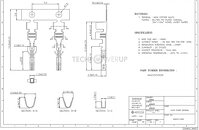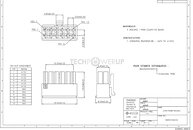Thursday, July 16th 2020

The Curious Case of the 12-pin Power Connector: It's Real and Coming with NVIDIA Ampere GPUs
Over the past few days, we've heard chatter about a new 12-pin PCIe power connector for graphics cards being introduced, particularly from Chinese language publication FCPowerUp, including a picture of the connector itself. Igor's Lab also did an in-depth technical breakdown of the connector. TechPowerUp has some new information on this from a well placed industry source. The connector is real, and will be introduced with NVIDIA's next-generation "Ampere" graphics cards. The connector appears to be NVIDIA's brain-child, and not that of any other IP- or trading group, such as the PCI-SIG, Molex or Intel. The connector was designed in response to two market realities - that high-end graphics cards inevitably need two power connectors; and it would be neater for consumers to have a single cable than having to wrestle with two; and that lower-end (<225 W) graphics cards can make do with one 8-pin or 6-pin connector.
The new NVIDIA 12-pin connector has six 12 V and six ground pins. Its designers specify higher quality contacts both on the male and female ends, which can handle higher current than the pins on 8-pin/6-pin PCIe power connectors. Depending on the PSU vendor, the 12-pin connector can even split in the middle into two 6-pin, and could be marketed as "6+6 pin." The point of contact between the two 6-pin halves are kept leveled so they align seamlessly.As for the power delivery, we have learned that the designers will also specify the cable gauge, and with the right combination of wire gauge and pins, the connector should be capable of delivering 600 Watts of power (so it's not 2*75 W = 150 W), and not a scaling of 6-pin. Igor's Lab published an investigative report yesterday with some numbers on cable gauge that helps explain how the connector could deliver a lot more power than a combination of two common 6-pin PCIe connectors.
Looking at the keying, we can see that it will not be possible to connect two classic six-pins to it. For example pin 1 is square on the PCIe 6-pin, but on NVIDIA's 12-pin is has one corner angled. It also won't be possible to use weird combinations like 8-pin + EPS 4 pin, or similar—NVIDIA made sure people won't be able to connect their cables the wrong way.
On topic of the connector's proliferation, in addition to PSU manufacturers launching new generations of products with 12-pin connectors, most prominent manufacturers are expected to release aftermarket modular cables that can plug in to their existing PSUs. Graphics card vendors will include ketchup-and-mustard adapters that convert 2x 8-pin to 1x 12-pin; while most case/power manufacturers will release fancy aftermarket adapters with better aesthetics.
Update 08:37 UTC: I made an image in Photoshop to show the new connector layout, keying and voltage lines in a single, easy to understand graphic.
Sources:
FCPowerUp (photo), Igor's Lab
The new NVIDIA 12-pin connector has six 12 V and six ground pins. Its designers specify higher quality contacts both on the male and female ends, which can handle higher current than the pins on 8-pin/6-pin PCIe power connectors. Depending on the PSU vendor, the 12-pin connector can even split in the middle into two 6-pin, and could be marketed as "6+6 pin." The point of contact between the two 6-pin halves are kept leveled so they align seamlessly.As for the power delivery, we have learned that the designers will also specify the cable gauge, and with the right combination of wire gauge and pins, the connector should be capable of delivering 600 Watts of power (so it's not 2*75 W = 150 W), and not a scaling of 6-pin. Igor's Lab published an investigative report yesterday with some numbers on cable gauge that helps explain how the connector could deliver a lot more power than a combination of two common 6-pin PCIe connectors.
Looking at the keying, we can see that it will not be possible to connect two classic six-pins to it. For example pin 1 is square on the PCIe 6-pin, but on NVIDIA's 12-pin is has one corner angled. It also won't be possible to use weird combinations like 8-pin + EPS 4 pin, or similar—NVIDIA made sure people won't be able to connect their cables the wrong way.
On topic of the connector's proliferation, in addition to PSU manufacturers launching new generations of products with 12-pin connectors, most prominent manufacturers are expected to release aftermarket modular cables that can plug in to their existing PSUs. Graphics card vendors will include ketchup-and-mustard adapters that convert 2x 8-pin to 1x 12-pin; while most case/power manufacturers will release fancy aftermarket adapters with better aesthetics.
Update 08:37 UTC: I made an image in Photoshop to show the new connector layout, keying and voltage lines in a single, easy to understand graphic.




178 Comments on The Curious Case of the 12-pin Power Connector: It's Real and Coming with NVIDIA Ampere GPUs
Die sizes for GPUs are much larger than die sizes for CPUs, so either the manufacturers will have to keep leaving performance on the table (but if the competition is animated, I have a hard time imagining that they will) or they will have to come with even better coolers. And given the form aspect of graphic cards, AIO coolers seems like a simpler option than doing 3-4 slot graphic cards with air coolers.
By this information now we may make our math about Max current transfer per plug.
But the very truth this is that industry this cares to level up the average constant current transfer and this should be 30% lower than the Max for safety reasons.
BTW, that's something you can do very well yourself, my 5700XT runs mostly passively cooled at 120W.
TPU should at the very least check what the Chinese text says instead of running with whatever BS leak comes to their hands , just saying !